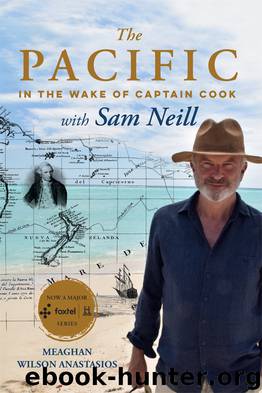The Pacific by Meaghan Wilson Anastasios

Author:Meaghan Wilson Anastasios
Language: eng
Format: epub
Publisher: HarperCollins
Published: 2018-06-19T16:00:00+00:00
Cook’s second voyage was underpinned by one thing – ambition. And the thing about ambition is that it’s not at all unusual for it to be frustrated, not to mention frustrating. Although Cook might have liked to discover the Great Southern Continent, he got the next best thing. As he sailed away from the Antarctic Circle for the final time, he knew he had confirmed once and for all that this continent was nothing more than a cartographer’s pipe dream. But as one imaginary continent vanished from the hypothetical horizon forever, Cook also understood that he was shedding light on another important and very real, if also very watery, world. You win some, you lose some.
The maritime possessions of the Polynesian residents of the Pacific would become a crucial bridge for Britain’s expansion into Asia. Although Cook, cut off from the homeland, was quite unaware of the renewed sense of urgency in Westminster, the lands he was charting would be the British Empire’s saving grace, filling in for the American colonies whose time was fast drawing nigh. In December 1773, as Cook turned his attention to Antarctica for the second time, Boston was having its Tea Party. Considering that the War of Independence kicked off about a year and a half later, Britain’s control of its American colonies was on borrowed time. And that made the Pacific all the more important to Mother England.
That doesn’t mean that the well-established Pacific nations were planning to give in without a fight. They harboured their own ambitions. Anchored in the shadows cast by the hundreds of monolithic stone statues looming above the barren landscape of Rapa Nui, Cook could be in no doubt that the race of determined and brave people – who had settled this island at the furthest edge of their world – would have their own, very clear, ideas about how their future should look. This was true of all Polynesians, including those in the 170-island-strong archipelago of Tonga.
The first European encounter with Tonga occurred in 1616 when Willem Schouten and Jacob Le Maire, sailed by the Niua Islands. In 1643 Abel Tasman visited the island of Tongatapu and bestowed upon it the name ‘New Amsterdam Island’. With nary a canal, a windmill or a clog in sight, the poor man must have been suffering severe homesickness. Tasman warmed to the Tongans, describing the locals as ‘good and peaceful people’.
These early visits made quite an impact on the locals. Today the Tongan word for white-skinned foreigners is pālangi, a term recorded by Cook in a phrase he transcribed, ‘towacka no papalangie’, and interpreted to mean ‘cloth ships’, referring to the billowing white sails that carried European vessels to Tongan shores.
When the Europeans began crisscrossing the Pacific, Tonga was a local superpower, and the island of Tongatapu its capital and home to its supreme leader. Blessed with fertile volcanic soils and cooperative prevailing winds that allowed its navigators to journey across the Pacific with ease, Tonga established itself as a wide-ranging
Download
This site does not store any files on its server. We only index and link to content provided by other sites. Please contact the content providers to delete copyright contents if any and email us, we'll remove relevant links or contents immediately.
Endurance: Shackleton's Incredible Voyage by Alfred Lansing(4510)
Tokyo Vice: An American Reporter on the Police Beat in Japan by Jake Adelstein(3867)
The Motorcycle Diaries by Ernesto Che Guevara(3789)
Alive: The Story of the Andes Survivors by Piers Paul Read(3736)
Exit West by Mohsin Hamid(3637)
Apollo 8 by Jeffrey Kluger(3514)
Aleister Crowley: The Biography by Tobias Churton(3428)
Annapurna by Maurice Herzog(3302)
Full Circle by Michael Palin(3271)
Into Thin Air by Jon Krakauer(3132)
Kitchen confidential by Anthony Bourdain(2834)
In Patagonia by Bruce Chatwin(2758)
A Wilder Time by William E. Glassley(2691)
Finding Gobi by Dion Leonard(2636)
Into the Wild by Jon Krakauer(2510)
The Ogre by Doug Scott(2506)
L'Appart by David Lebovitz(2397)
The Stranger in the Woods by Michael Finkel(2330)
An Odyssey by Daniel Mendelsohn(2209)
